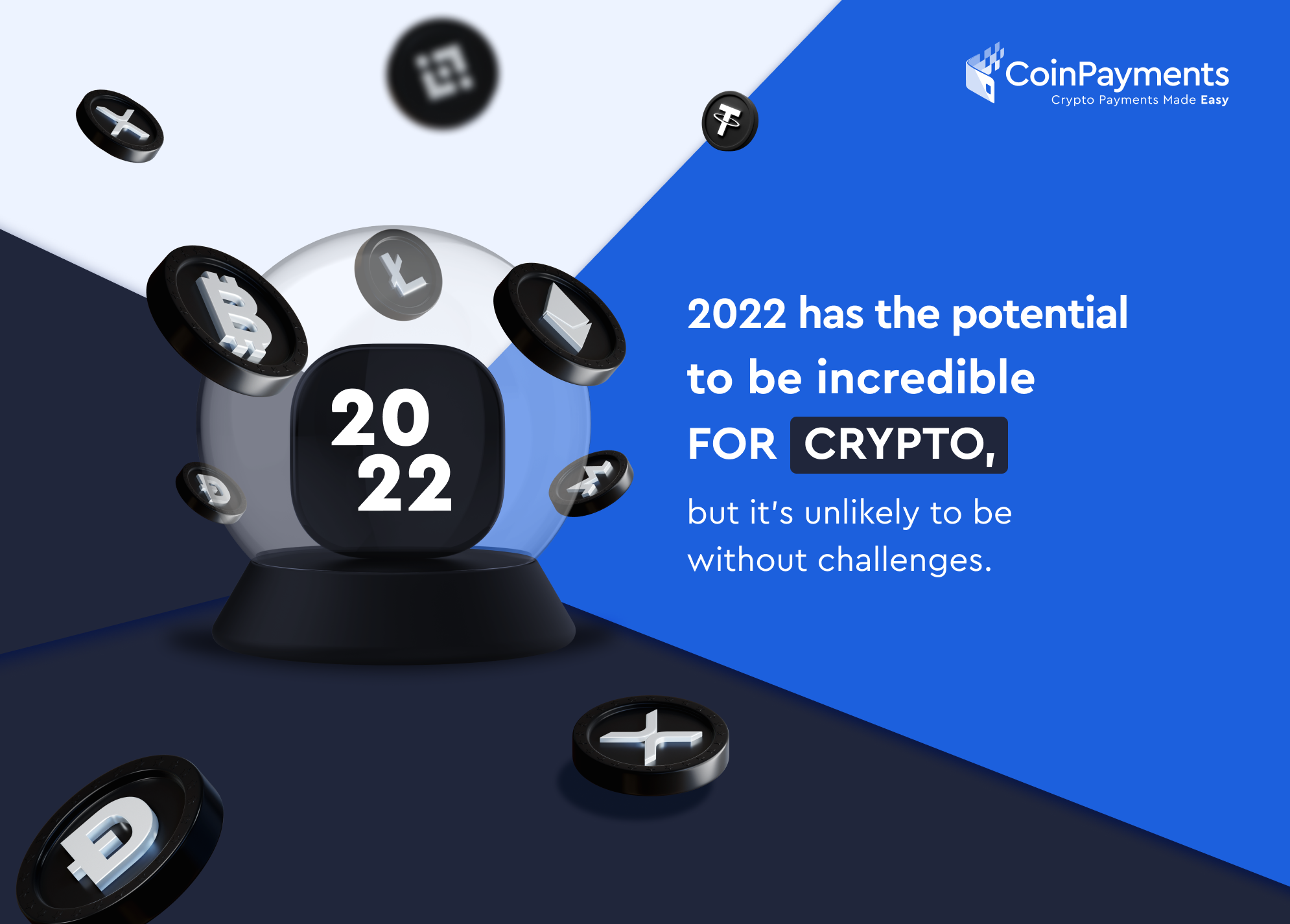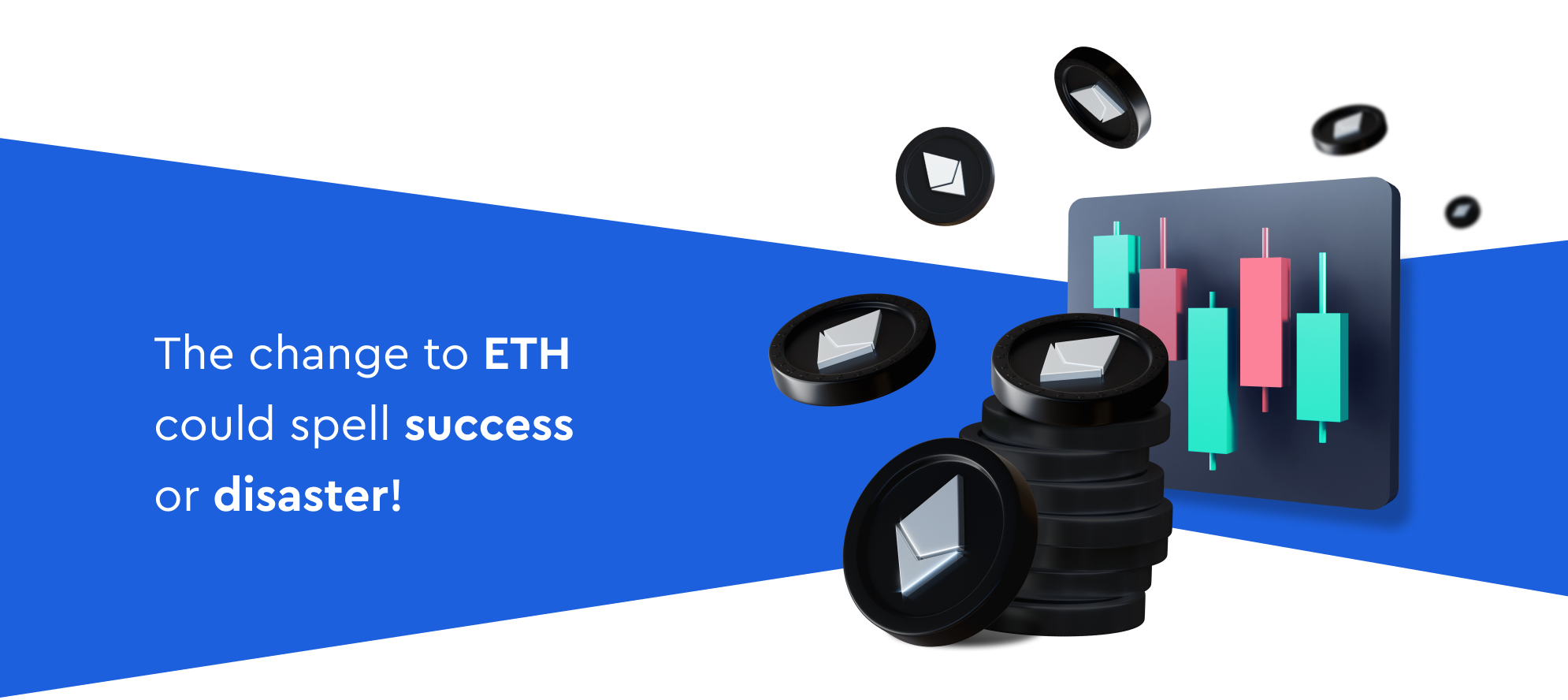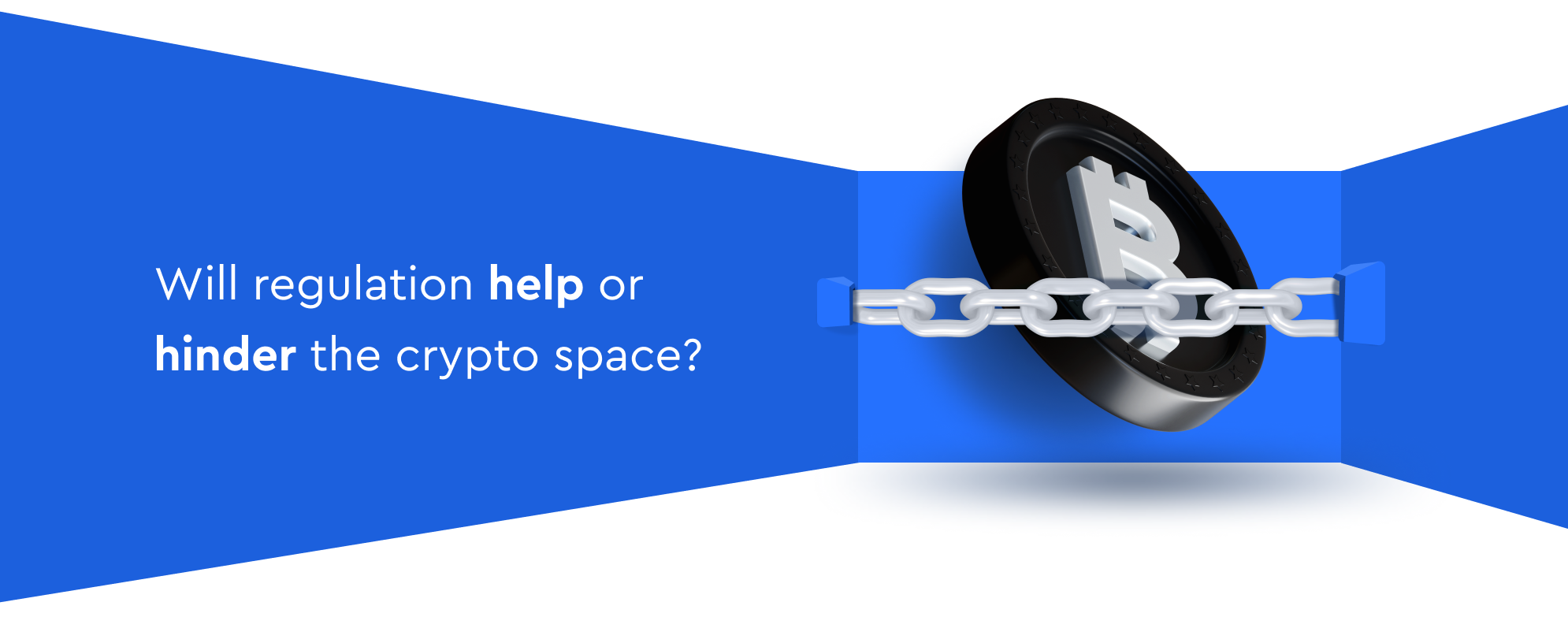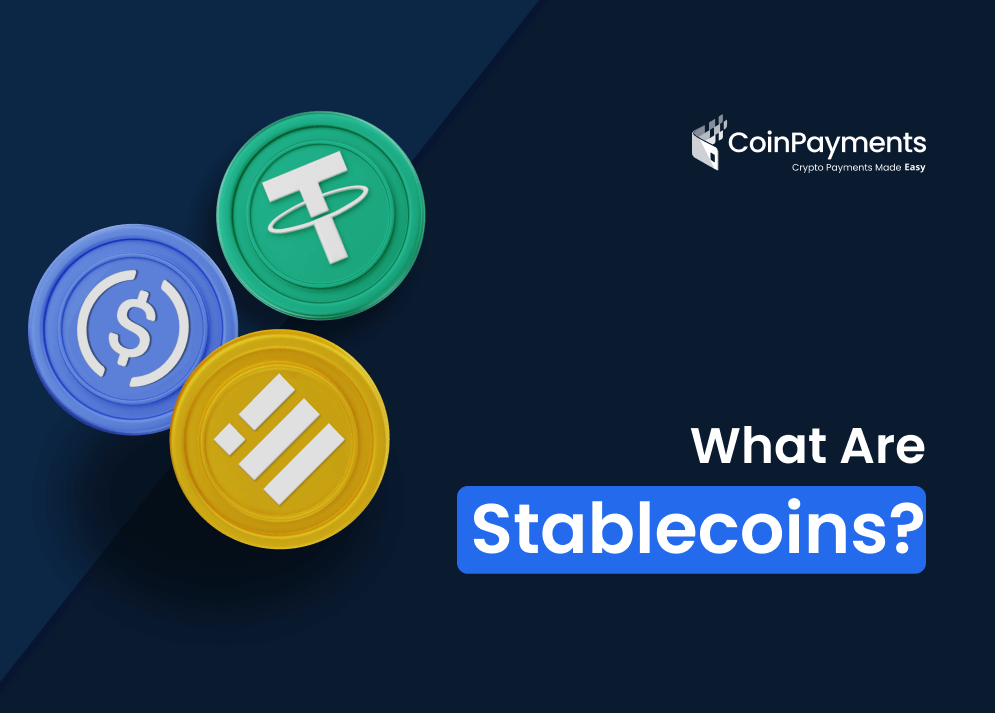
2021 was an incredible year for many aspects of the crypto space. From massive price jumps, with Bitcoin jumping from $29,374 to highs of $67,566, through to widespread adoption and acceptance of NFTs with OpenSea (the main NFT marketplace) seeing a 64,600% increase in trading volume, there was plenty happening to keep existing holders happy and to draw new people into crypto.
In this article, we’re going to look ahead at what’s coming soon, and what you might expect to see during 2022, from technological improvements through to changes in the way we understand business models enabled by blockchain and cryptocurrency technology.
With that in mind, there will always be a level of fluctuation and instability in the crypto markets, and, as with every year so far since Bitcoin first launched in 2009, there will certainly be some challenges.
Ethereum (finally) upgrades

One of the big events expected during 2022 has to be the long-awaited swap for Ethereum moving from Proof of Work (the system it currently uses which is slower, has high energy requirements, and creates high fees) to Proof of Stake (which will, in theory, be faster, enable lower fees and use much less power).
While Ethereum is already the leader among smart-contract solutions, the current high fees often price smaller projects out, particularly new NFT projects.
High fees also negatively affect DeFi (Decentralised Finance) projects looking to build on the platform. For example, a DeFi Project where you stake $100 of tokens to get $500 back becomes a lot less attractive when you need to pay over $100 in fees to put your tokens in, and the same again to withdraw them.
There are also a lot of questions raised by those outside the crypto and NFT space around energy consumption, which is becoming one of the major cases against adoption.
Currently, there is a push for developers and consumers to use alternative chains or layer 2 solutions (cryptocurrency chains that sit “on top” of existing chains and solve some of these problems), such as Polygon, to build on. The planned move to Proof of Stake could enable massive growth in Ethereum-based solutions and help cement it as the primary platform for further development.
While it feels like the community has been waiting a long time for the change to Proof of Stake, this year it seems likely it will happen and could be a game-changer for the industry.
That said, a move from the well-established Proof of Work model to Proof of Stake is not without its challenges and nay-sayers, so how the Ethereum community handles these after the change will be critical in its success.
Global Environmental Impact will be key

Energy usage of blockchain technology, in particular around the growth of Bitcoin and the NFT space, has created a backlash of public opinion around their suitability as a long-term solution and their environmental soundness.
Using Proof of Work as a basis for security does create high energy usage, and there is often fierce debate among crypto enthusiasts as to what the best long-term solution is.
Some feel the energy usage is a worthwhile cost to create decentralized financial systems and models of ownership. They look at methods of increasing the renewable energy usage of their chain through locating mining (the process of generating new blocks and often minting new coins) into locations where hydro, solar power, or in the case of El Salvador a volcano, are readily available.
Others feel that, particularly for non-monetary solutions, their technology can work securely using alternative solutions that are less power-intensive. Ethereum is the biggest to make this move with its planned change to Proof of Work but is far from the only cryptocurrency out there to do so.
In 2022, we expect the debate to become fiercer, in particular, if the value of currencies continues to rise, NFTs become more common and mainstream, and environmental issues such as global warming continue to be issues faced.
As a result, alternative solutions are likely to be implemented, governments may step in with further legislation around the issue, and education among new users about how individual solutions operate will be critical to preventing objections that slow the pace of development.
We are also likely to see an increase in the number of projects moving into the space that heavily promote their “green” aspects, potentially while glossing over some of the other changes they have made to allow greener solutions!
Gamers win big as “play to earn” takes off

Play to earn, as a model of gaming and income has become a major factor in 2021 and we expect this trend to continue into 2022.
Games such as Splinterlands and AxieInfinity have proven the model works, raising both huge sums for the companies behind them and for the players, both casual and regular.
As we move into 2022, expect established companies in the crypto space to continue to develop new models for rewarding and drawing in new players, as well as for non-blockchain gaming companies to move into the space.
While some have already tentatively started this, such as Ubisoft announcing their “Digits” NFT solution, there are many players outside the blockchain space who are not happy about it and those early adopters are facing some vocal backlash.
As the entire space moves forward and addresses such issues as energy usage, it is likely that more established companies will move into the space, plus new players will be drawn in by the existing blockchain-native play-to-earn games.
A reduction in the perceived issues of the technology, paired with an increasing education model for newcomers and better rewards, could bring massive growth in this area and enable people globally to utilize play-to-earn gaming as a primary source of income.
While we are already seeing this in occasional instances, it tends towards players who started a particular game early, purchased NFTs before they increased in value, and have an unbalanced collection of assets. Games with longer-term player goals will have to develop models that reward new players and shift further from assets created at launch into rewarding actual gameplay.
The play-to-earn model is certainly not without challenges, but as more players see the benefits, they will likely start to demand it from gaming companies.
Regulators Increase their influence on the space

Cryptocurrencies and the technologies enabled by blockchain have stood outside of mainstream legislation for a long time now. While some governments have tried to fit them into established frameworks for assets or currencies, others have been content to let them develop before legislating.
Given the huge rise of value within the space during 2021 and the potential for a wider market pullback in 2022, it is likely that we will see increased regulation.
From the base value increase in currencies such as Bitcoin and Ether (the currency of Ethereum), the value locked in staking through DeFi, and the values being exchanged for blue-chip NFT projects such as CryptoPunks and Bored Ape Yacht Club, there is now a lot of attention from traditional financial institutions and larger governing bodies.
In particular, one of the largest critical issues to be faced by the community is how to remove funds from the space and move back into Fiat (EG GBP, USD, or EUR). Exchanges want to know the source of funds to maintain their own regulation, banks won’t accept large transfers from unknown sources, and tax regulations are often confusing.
As a result, many large players in the space are finding they can generate massive incomes and funds within crypto, but are then unable to easily use it outside of that space, and are actively encouraging legislation to enable them to do so.
As increased legislation comes into play, assuming it does not heavily restrict some aspects we have become accustomed to, we are also likely to see increased movement from traditionally non-crypto institutions who would gain some of the protections they (and their investors) are accustomed to within the traditional financial world.
The question of if new legislation will hamper the space, pushing people to move from crypto back into Fiat, or encourage more people to move from Fiat into crypto, is yet to be answered, but it will certainly be an interesting time.
The Decentralized Autonomous Organization model becomes accepted

The DAO (or Decentralised Autonomous Organisation) is a relatively new business model that comes from the idea of each participant in a venture having equal access and control.
Unlike traditional business hierarchies, the DAO helps create a relatively flat hierarchy with each participant having an equal vote or say on any action, for example, based on how many of a token they choose to hold.
Rather than being centrally controlled, a DAO then takes actions based on the smart contracts (code and software) that run it, with every vote or action being open for all members to see and confirm.
While it is still in its infancy, the DAO model has proven popular among blockchain and crypto fans, with one DAO (ConstitutionDAO) attempting to purchase one of the first thirteen copies of the US Declaration of Independence.
In 2022, we are likely to see more DAOs appear, with smart-contracting technology allowing decisions to be made along several lines, from ownership of tokens through to rewarding those who actively participate or make “good” choices during the life of the DAO.
While many are based on the ownership of a token that might be bought by anyone in any location, some are looking to legislation that would enable geo-locked DAO’s or restricted purchasing to a select group, ensuring they are legally able to operate within certain areas.
As the technology moves forwards, it is possible we will even see entire companies and businesses moving to the DAO model with a focus on rewarding everybody who is part of it equally and removing some of the pay gaps between traditional senior staff and others in the company.
The rollercoaster ride of crypto will continue

2022 promises to be very interesting for the entire cryptocurrency and blockchain space.
In 2021 there were plenty of new ideas, new models, and new ways of utilizing the technology developed, so in 2022 those ideas that have proved worthy will continue to develop with more people moving into the space and increased value held within it.
With that increased attention will come new legislation, some positive for the space, some less so, and how the established crypto-users and newcomers react and handle that will be critical.
Just as it always has, the crypto space will continue to face challenges during 2022, from price fluctuations and corrections, through to calls for it to be banned. But, as we have seen previously, the strength of the crypto community will be what drives the technology to new heights of adoption and usage.

Disclaimer: Please note, nothing in this article should be construed as financial or investment advice, nor should it be taken as an endorsement of any particular technology or business model.



